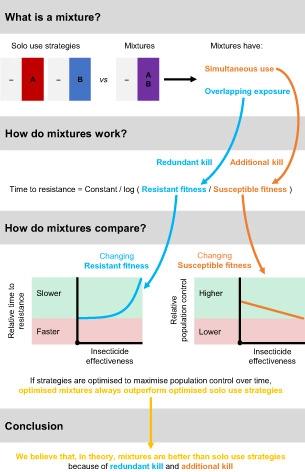当前位置:
X-MOL 学术
›
Pest Manag. Sci.
›
论文详情
Our official English website, www.x-mol.net, welcomes your feedback! (Note: you will need to create a separate account there.)
Beyond redundant kill: A fundamental explanation of how insecticide mixtures work for resistance management
Pest Management Science ( IF 4.1 ) Pub Date : 2022-09-13 , DOI: 10.1002/ps.7180 Philip G Madgwick 1 , Ricardo Kanitz 2
Pest Management Science ( IF 4.1 ) Pub Date : 2022-09-13 , DOI: 10.1002/ps.7180 Philip G Madgwick 1 , Ricardo Kanitz 2
Affiliation

|
The use of insecticide mixtures for resistance management has been a controversial topic for many decades. Here, we provide a reassessment of the fundamental theory of insecticide mixtures. First, we examine how mixtures differ from other strategies. We suggest that the fundamental strategy concept of a mixture is defined by the simultaneous use of insecticides and their overlapping exposure. Second, we provide a simple, illustrative model to show how mixtures affect resistance evolution. Following the existing literature, we identify a role for ‘redundant kill’ acting against resistant individuals, which we link to the overlapping exposure of insecticides. We also identify the occurrence of ‘additional kill’ acting against susceptible individuals, which is the immediate consequence of the simultaneous use of insecticides. Third, we take a basic approach to the comparison of mixtures and other strategies using a simple model. We find that a common comparison of the time to resistance alone leaves the effects of additional kill unaccounted for. Moreover, we demonstrate that different approaches to comparison can lead to different results because of biases that are introduced in the comparison setup. Fourth, still using the same model, we showcase a more sophisticated approach to comparison using optimised strategies. We find that optimised mixtures always perform better than other strategies due to the combination of redundant and additional kill. We suggest that the comparison of optimised strategies is unbiased because each strategy is performing the best that it can. On this basis, in theory (but not necessarily practice), we believe that mixtures are better than other strategies and, through the steps of our argument, we can tie this success back to the fundamental properties (of simultaneous use and overlapping exposure) that distinguish mixtures from other strategy concepts. © 2022 The Authors. Pest Management Science published by John Wiley & Sons Ltd on behalf of Society of Chemical Industry.
中文翻译:

超越冗余杀灭:杀虫剂混合物如何用于抗药性管理的基本解释
几十年来,使用杀虫剂混合物进行抗药性管理一直是一个有争议的话题。在这里,我们重新评估了杀虫剂混合物的基本理论。首先,我们检查混合策略与其他策略有何不同。我们建议混合物的基本策略概念由同时使用杀虫剂及其重叠暴露来定义。其次,我们提供了一个简单的说明性模型来展示混合物如何影响抗性演变。根据现有文献,我们确定了针对耐药个体的“冗余杀戮”作用,我们将其与杀虫剂的重叠接触联系起来。我们还确定了针对易感个体的“额外杀戮”的发生,这是同时使用杀虫剂的直接后果。第三,我们采用一种基本方法来比较混合策略和使用简单模型的其他策略。我们发现,仅将抵抗时间进行常见比较,就无法解释额外杀戮的影响。此外,我们证明,由于比较设置中引入的偏差,不同的比较方法可能会导致不同的结果。第四,仍然使用相同的模型,我们展示了一种使用优化策略进行比较的更复杂的方法。我们发现,由于冗余和额外杀伤的结合,优化的混合物总是比其他策略表现更好。我们建议优化策略的比较是公正的,因为每个策略都在发挥其所能达到的最佳效果。在此基础上,理论上(但不一定实践),我们相信混合比其他策略更好,并且通过我们论证的步骤,我们可以将这种成功与将混合与其他策略概念区分开来的基本属性(同时使用和重叠暴露)联系起来。© 2022 作者。Pest Management Science由 John Wiley & Sons Ltd 代表化学工业协会出版。
更新日期:2022-09-13
中文翻译:

超越冗余杀灭:杀虫剂混合物如何用于抗药性管理的基本解释
几十年来,使用杀虫剂混合物进行抗药性管理一直是一个有争议的话题。在这里,我们重新评估了杀虫剂混合物的基本理论。首先,我们检查混合策略与其他策略有何不同。我们建议混合物的基本策略概念由同时使用杀虫剂及其重叠暴露来定义。其次,我们提供了一个简单的说明性模型来展示混合物如何影响抗性演变。根据现有文献,我们确定了针对耐药个体的“冗余杀戮”作用,我们将其与杀虫剂的重叠接触联系起来。我们还确定了针对易感个体的“额外杀戮”的发生,这是同时使用杀虫剂的直接后果。第三,我们采用一种基本方法来比较混合策略和使用简单模型的其他策略。我们发现,仅将抵抗时间进行常见比较,就无法解释额外杀戮的影响。此外,我们证明,由于比较设置中引入的偏差,不同的比较方法可能会导致不同的结果。第四,仍然使用相同的模型,我们展示了一种使用优化策略进行比较的更复杂的方法。我们发现,由于冗余和额外杀伤的结合,优化的混合物总是比其他策略表现更好。我们建议优化策略的比较是公正的,因为每个策略都在发挥其所能达到的最佳效果。在此基础上,理论上(但不一定实践),我们相信混合比其他策略更好,并且通过我们论证的步骤,我们可以将这种成功与将混合与其他策略概念区分开来的基本属性(同时使用和重叠暴露)联系起来。© 2022 作者。Pest Management Science由 John Wiley & Sons Ltd 代表化学工业协会出版。



























 京公网安备 11010802027423号
京公网安备 11010802027423号